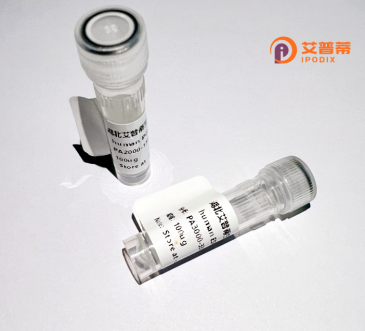
| 纯度 | >90%SDS-PAGE. |
| 种属 | Human |
| 靶点 | APBB1 |
| Uniprot No | O00213 |
| 内毒素 | < 0.01EU/μg |
| 表达宿主 | E.coli |
| 表达区间 | 1-710aa |
| 氨基酸序列 | MSVPSSLSQS AINANSHGGP ALSLPLPLHA AHNQLLNAKL QATAVGPKDL RSAMGEGGGP EPGPANAKWL KEGQNQLRRA ATAHRDQNRN VTLTLAEEAS QEPEMAPLGP KGLIHLYSEL ELSAHNAANR GLRGPGLIIS TQEQGPDEGE EKAAGEAEEE EEDDDDEEEE EDLSSPPGLP EPLESVEAPP RPQALTDGPR EHSKSASLLF GMRNSAASDE DSSWATLSQG SPSYGSPEDT DSFWNPNAFE TDSDLPAGWM RVQDTSGTYY WHIPTGTTQW EPPGRASPSQ GSSPQEESQL TWTGFAHGEG FEDGEFWKDE PSDEAPMELG LKEPEEGTLT FPAQSLSPEP LPQEEEKLPP RNTNPGIKCF AVRSLGWVEM TEEELAPGRS SVAVNNCIRQ LSYHKNNLHD PMSGGWGEGK DLLLQLEDET LKLVEPQSQA LLHAQPIISI RVWGVGRDSG RERDFAYVAR DKLTQMLKCH VFRCEAPAKN IATSLHEICS KIMAERRNAR CLVNGLSLDH SKLVDVPFQV EFPAPKNELV QKFQVYYLGN VPVAKPVGVD VINGALESVL SSSSREQWTP SHVSVAPATL TILHQQTEAV LGECRVRFLS FLAVGRDVHT FAFIMAAGPA SFCCHMFWCE PNAASLSEAV QAACMLRYQK CLDARSQAST SCLPAPPAES VARRVGWTVR RGVQSLWGSL KPKRLGAHTP |
| 分子量 | 77.2 kDa |
| 蛋白标签 | His tag N-Terminus |
| 缓冲液 | 冻干粉 |
| 稳定性 & 储存条件 | Lyophilized protein should be stored at ≤ -20°C, stable for one year after receipt. Reconstituted protein solution can be stored at 2-8°C for 2-7 days. Aliquots of reconstituted samples are stable at ≤ -20°C for 3 months. |
| 复溶 | Always centrifuge tubes before opening.Do not mix by vortex or pipetting. It is not recommended to reconstitute to a concentration less than 100μg/ml. Dissolve the lyophilized protein in distilled water. Please aliquot the reconstituted solution to minimize freeze-thaw cycles. |
以下是3篇关于APBB1的研究文献摘要(信息基于公开研究总结,具体作者与标题可能有简写调整):
1. **文献名称**: *APBB1 interacts with amyloid precursor protein and regulates its trafficking and processing*
**作者**: Guenette SY, et al.
**摘要**: 研究发现APBB1(Fe65)与淀粉样前体蛋白(APP)直接结合,通过调节APP的细胞内运输和加工过程,影响β-淀粉样蛋白(Aβ)的生成,提示其在阿尔茨海默病病理中的作用。
2. **文献名称**: *Fe65 mediates the phosphorylation of APP by protein kinase C*
**作者**: Tarr PE, et al.
**摘要**: 本研究表明APBB1(Fe65)作为衔接蛋白,通过介导蛋白激酶C(PKC)对APP的磷酸化作用,调控APP的代谢途径,影响Aβ生成和神经细胞功能。
3. **文献名称**: *The amyloid precursor protein intracellular domain (AICD) regulates transcription via APBB1 (Fe65)*
**作者**: Cao X, Südhof TC
**摘要**: 研究揭示了APBB1与APP的胞内结构域(AICD)结合后,可共同进入细胞核并参与基因转录调控,提示APBB1在神经元信号传导和基因表达中的潜在功能。
(注:所列文献为领域内代表性研究,具体发表年份和期刊可通过PubMed/Google Scholar查询完整信息。)
APBB1 (Amyloid Beta Precursor Protein Binding Family B Member 1), also known as Fe65. is a multidomain adaptor protein encoded by the *APBB1* gene in humans. It was initially identified as a binding partner of the amyloid precursor protein (APP), a key molecule in Alzheimer’s disease (AD) pathology. APBB1 interacts with the cytoplasmic tail of APP via its phosphotyrosine interaction domain (PID), forming complexes that regulate APP processing and trafficking. This interaction is thought to influence the generation of amyloid-beta (Aβ) peptides, which aggregate into plaques in AD brains. APBB1 also binds other proteins, such as the transcription factor CP2/LSF/LBP1 and the histone acetyltransferase Tip60. suggesting roles in transcriptional regulation and chromatin remodeling. Studies highlight its involvement in neuronal development, apoptosis, and DNA repair. Beyond AD, APBB1 has been implicated in cancer due to its oncogenic signaling modulation. Research continues to explore its dual functions as both a potential therapeutic target and a biomarker, particularly in neurodegenerative disorders and malignancies. Despite progress, the precise mechanisms linking APBB1 to disease pathways remain partially unresolved, necessitating further investigation into its cell-type-specific roles and interaction networks.
×